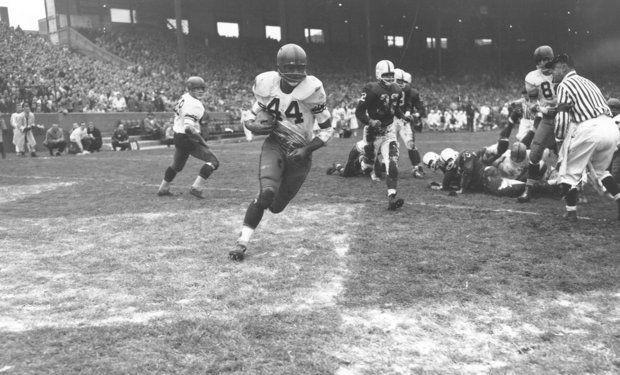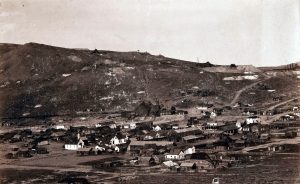Ernie Davis is remembered as one of the most dynamic running backs in NCAA football history. Overcoming adversity is something he had been doing since the time he was born in 1939 in his hometown of New Salem, Pennsylvania. A few days after Ernie was born, his father passed away and his mother was not in the condition to take care of her newborn child. So, Ernie was raised by his maternal grandparents in Uniontown, Pennsylvania. Growing up, Ernie had a bad stuttering problem leaving it hard for him to communicate with others, but his grandparents helped him cope with it and managed to instill strong faith and discipline in him. When Ernie turned twelve, his mother returned back to his life and had him move to Elmira, New York. As Ernie grew older, people all around town began raging about Ernie “the Elmira Express” Davis and his dynamic football skills. He was actively recruited by dozens of colleges. But swayed by his hero Jim Brown, he was convinced to attend the University of Syracuse.1

When Ernie Davis arrived at Syracuse in 1958, his welcome was anything but warm. His own teammates would beat him and target him in practice. There was an incident where a defensive player threw Ernie to the floor and beat him until the coaches pulled him off of Ernie. But, Coach Floyd Benjamin “Ben” Schwartzwalder pushed very hard to get the team to play as one and respect each other as a team rather than hate each other because of the color of their skin. Once Ernie became adapted to the school, and once his teammates warmed up to him, he was moved up to varsity. This was when Coach Schwartzwalder began to shape the young Ernie Davis into the Elmira Express that he would forever be remembered as. In practice, he quickly adapted to this collegiate level and was named the new starting running back for the season to come.2

After Syracuse finished the 1959 season with a respectable record of 8-2 and finishing tenth in the nation, many were hopeful for what the future held for the Fighting Orangemen. So, at the start of the 1960 football season, there were high expectations for both the young Ernie Davis and the Syracuse Fighting Orangemen.3 The Coaches and Boosters of the university questioned whether or not Davis would be able to fill the shoes of future Hall of Famer Jim Brown, and many wondered whether he could lead Syracuse to their first National Championship victory. Ernie Davis and the Fighting Orangemen hit the ground running and went undefeated in the regular season beating nine teams by over a twenty-one point margin.4
The regular season would be nothing compared to what they were going to face in the 1960 Cotton Bowl. The night before the highly anticipated game, Ernie and his team arrived in Dallas, and the hotel they made reservations at refused to let Ernie and two other teammates stay in the main part of the hotel. That night Ernie had to stay in the basement level of the hotel where he woke up to a pile of death threats and letters telling him not to compete in the Cotton Bowl. In fear of a violent outburst at the game, the Mayor of Dallas, Robert Lee Thornton, sent snipers to the stadium in an effort to try to ensure peace during the game.5
The moment of truth had finally come for the Orangemen, and it was time for the Elmira Express to lead his team to a National Championship victory at the Cotton Bowl. From the moment the ball was kicked off it was clear that Davis was playing on another level, as he averaged 7.8 yards per carry. As the game progressed, Ernie started getting beat up after plays, particularly in dog piles, and they gradually got worse. Tensions between the two teams were rising. Ernie Davis was beaten so badly after one play that he had to be escorted to the locker room so a doctor could look at his already injured hamstring. But, Davis would later be returned to the game, after going against what the doctor had suggested, which was to sit out the rest of the game and take it easy. Halftime was approaching and the score was 15-0. Syracuse was up and the aggression and altercations began to get worse. Then: “John Brown, a Negro lineman, played nose to nose against 235-pound Texas tackle Larry Stephens. To goad him off balance, Brown claimed, Stephens kept calling him ‘a big black dirty nigger.’ Finally, Brown warned him not to call him that again. When Stephens did, Brown swung.”6 That punch exploded into an all-out brawl between Texas and Syracuse, which would come to be known as “The Battle of the Hard-Noses.” Syracuse eventually went on to win the Cotton Bowl and claim their first National Championship in school history.7
The 1961 season came, and Ernie Davis just kept getting better. That season, he averaged 7.8 yards per carry and ended up breaking the school record for touchdowns in a single season. Everyone in the country was watching The Elmira Express shatter records and continue to carry his team to victory. The Fighting Orangemen would end up finishing the season 8-3, and finished sixteenth in the country and won the Liberty Bowl.8 Once the Season was concluded, the press and people began to discuss the Heisman Trophy Ceremony. Even President John F. Kennedy sent Ernie Davis a telegram commending him on fighting and competing in a sport he loved, and wished him luck in his NFL career and the upcoming Heisman Trophy Ceremony. Although the president was very supportive of young Ernie Davis, much of the country still made it hard for Davis to go places or be normal. There were many reports that he had still been receiving death threats constantly since the Cotton Bowl. There was even an incident where people were throwing food at him in public while he was on a run in the weeks leading up to the Heisman.9

For many years, African-American players weren’t even considered for the Heisman Trophy. Even the NFL Hall of Famer and Ernie Davis’s hero, Jim Brown, was nominated and clearly deserved the Heisman in 1958. When the day of the Heisman Trophy Ceremony had finally arrived, there was still no clear candidate that stuck out as the next Heisman trophy winner. So who would win was still very unclear to the country. But in 1961, Ernie Davis became the first African American to win the Heisman Trophy, and JFK was there to present the trophy to him personally. This event gave the Civil Rights movement momentum, and helped Americans begin to see that this concept of equality could be achieved.10
After winning the Heisman Trophy, Ernie Davis was prepared for the All-American game and was drafted by the Cleveland Browns as the first overall pick in the 1962 NFL draft. One day, while at practice, Davis passed out and laid unconscious on the field, and was rushed to the hospital. He was placed in the hospital for an extended period of time, and the doctors ran numerous tests on him. After this time, he was eventually released from the Cleveland Browns because they discovered that he had been diagnosed with leukemia.11
On May 18, 1963, Ernie the Elmira Express Davis died. Ernie Davis changed the game of football; he was the first African American to win the Heisman and be the first pick in the NFL draft. Davis never said much, but he led by action, and made change through action. He became an inspiration to a lot of people in American society and refused to ever let the color of his skin hold him back from chasing his dreams. He will forever be remembered for that.12
- Eric Quackenbush, “Ernest ‘Ernie’ Davis: The Elmira Express,” Bleacher Report, June 24, 2009. Accessed February 7, 2018. http://bleacherreport.com/articles/205915-ernest-ernie-davis-the-elmira-express. ↵
- Brad Kelly, “Ernie Davis, Uplifting Champ Rush To The Top: He led Syracuse to the national title before his young death,” Investors Business Daily, December 14, 2009. Accessed January 29, 2018. ↵
- Eric Quackenbush, “Ernest ‘Ernie’ Davis: The Elmira Express,” Bleacher Report, June 24, 2009. Accessed February 7, 2018. http://bleacherreport.com/articles/205915-ernest-ernie-davis-the-elmira-express. ↵
- Eric Quackenbush, “Ernest ‘Ernie’ Davis: The Elmira Express,” Bleacher Report, June 24, 2009. Accessed February 7, 2018. http://bleacherreport.com/articles/205915-ernest-ernie-davis-the-elmira-express. ↵
- Ben Cosgrove, “LIFE at the 1960 Cotton Bowl: ‘Battle of the Hard-Noses’,” Time, January 2, 2014. Accessed January 29, 2018. http://time.com/3878581/cotton-bowl-1960-when-syracuse-whipped-texas-forthe-national-title/. ↵
- Ben Cosgrove, “LIFE at the 1960 Cotton Bowl: ‘Battle of the Hard-Noses’,” Time, January 2, 2014. Accessed January 29, 2018. http://time.com/3878581/cotton-bowl-1960-when-syracuse-whipped-texas-forthe-national-title/. ↵
- Ben Cosgrove, “LIFE at the 1960 Cotton Bowl: ‘Battle of the Hard-Noses’,” Time, January 2, 2014. Accessed January 29, 2018. http://time.com/3878581/cotton-bowl-1960-when-syracuse-whipped-texas-forthe-national-title/. ↵
- Eric Quackenbush, “Ernest ‘Ernie’ Davis: The Elmira Express,” Bleacher Report, June 24, 2009. Accessed February 7, 2018. http://bleacherreport.com/articles/205915-ernest-ernie-davis-the-elmira-express. ↵
- Eric Quackenbush, “Ernest ‘Ernie’ Davis: The Elmira Express,” Bleacher Report, June 24, 2009. Accessed February 7, 2018. http://bleacherreport.com/articles/205915-ernest-ernie-davis-the-elmira-express. ↵
- Sean Krist, “Ernie Davis and JFK: More than 50 years ago, key figures in D.C. football time of change,” Syracuse.com, August 20, 2o14. Accessed February 21, 2017, http://www.syracuse.com/kirst/index.ssf/2014/08/ernie_davis_and_jfk_more_than_50_years_ago_key_figures_in_another_dc_football_ca.html. ↵
- Eric Quackenbush, “Ernest ‘Ernie’ Davis: The Elmira Express,” Bleacher Report, June 24, 2009. Accessed February 7, 2018. http://bleacherreport.com/articles/205915-ernest-ernie-davis-the-elmira-express. ↵
- Salem Press Biographical Encyclopedia, January 2016, s.v. “Ernie Davis,” by Stephen Schwartz. ↵



64 comments
Maricela Guerra
It’s nice to read things that people who put in dedication and hard work and it all pays off. Personally I am not a fan with football, however when it comes to hearing stories of those who become pros, and those who work at becoming better are really interesting. Those who are passionate at becoming better, are the ones who will go far.
Rafael Lopez-Rodriguez
What a great and inspiring story!!! I have not heard of the story of Ernie Davis before and I enjoyed reading this story from beginning to end. What Ernie was able to do in the time he lived I believe really set the tone for the civil rights movement that was going on. When you overcome adversity and prove the people that doubt you wrong is a very strong relief especially in an athlete. Because I know the life of an athlete is full of adversity. I believe Ernie Davis is an athlete that many look up to, especially for African-Americans.
Luis Morales
Before reading this article, I had never heard of the story of Ernie Davis or saw the movie, “The Express.” But from what I heard about him in the article and researching him myself, I found out that not only one of the best college football players in history but he was also one of the most passionate players you could have watched during this time. What was also amazing about Ernie Davis was his passion of the field. Davis faced many challenges in life. Challenges like troubles at home, speech impediments, and racial judgments. However Ernie was able to pull though and succeed, becoming the first African American to win the Heisman Trophy. Great Article.
Vanessa Tombo
Ernie Davis is an inspiration to all who know his story. I am thankful to say that I too can consider myself inspired. There are many injustices that occur in the world around us. For some they are unable to cope and they let the world define who they are meant to be. However, this is not the case for Davis while facing adversity he stands a=strong and follows his passion for playing football. He did not allow the way his own teammate’s mistreatment to influence the passion he kept doing what he was best at which was play football. Overall a well-written article. Incredible job!
Kayla Lopez
Despite being a football fan, I have not really heard about this story or watched the movie, “The Express.” It is always nice to see a person become so passionate about what they are doing that they put up with mistreatment and adversity. This is not always easy to do so it is always inspiring to see someone do what others never believed possible. This was a very well written essay that was organized perfectly.
Noah Laing
I’ve always found Ernie Davis’ story extremely inspiring, so I really enjoyed reading this article. Davis wasn’t only one of the best college football players in history, but also an outstanding man, as he was able to overcome trouble at home, speech impediments, racial judgement, and inspire so many with all of success, which included becoming the first African American to win the Heisman Trophy. That feat of winning the Heisman was more than just recognition of the best college football player that year, but as this article explains, it also helped the civil rights movement and make America take one step closer to equality. Also, there’s a movie about Ernie Davis’ story called The Express, which I’d highly recommend to anyone who has the slightest interest in this story.
Brandon Martinez
I’ve previously seen the movie “The Express” about Ernie, but besides that i did not know much about him besides his football career. It was interesting to learn about the tensions that surrounded him while playing throughout the country, and the troubles he went through while playing. Being a great athlete making it into the pros is amazing, but the fact that he was able to do this while fighting against people who mistreated him due to race is even more impressing. Your article is well written and really shows the journey and struggle he went through. Good article!
Samuel Stallcup
The NCAA is an important sports organization for sports history because it allows college students to show their talents on a larger stage. This allows for the student to be seen by many professional teams and therefore possibly begin their career as a professional athlete. I think that without the NCAA amazing stories such as this would not be possible, and this article gives a good story on why we must celebrate the NCAA and its members.
Miguel Camarillo-Cohen
This was very well written article. I am familiar with the captivating story of the “Elmira Express;” Ernie Davis was an incredible human being who broke through social barriers for African Americans and people of color alike. However, I did not realize that he was separated from his mother as well as his father passing away, at a young age. His story is truly inspiring.
Natalie Childs
This was an incredibly well written article. I really enjoyed the level of detail that the author used. While I had heard the named Ernie Davis, and knew that he was a great in football, I had never really known much more than that. It is crazy to me that the threat of violence at the Cotton Bowl was so great that snipers had to be put in place for the safety of the players and those in attendance and that an all out brawl occurred because lack of respect between the teams. Ernie was really a trailblazer in sports and football, and will be always remembered as a great.